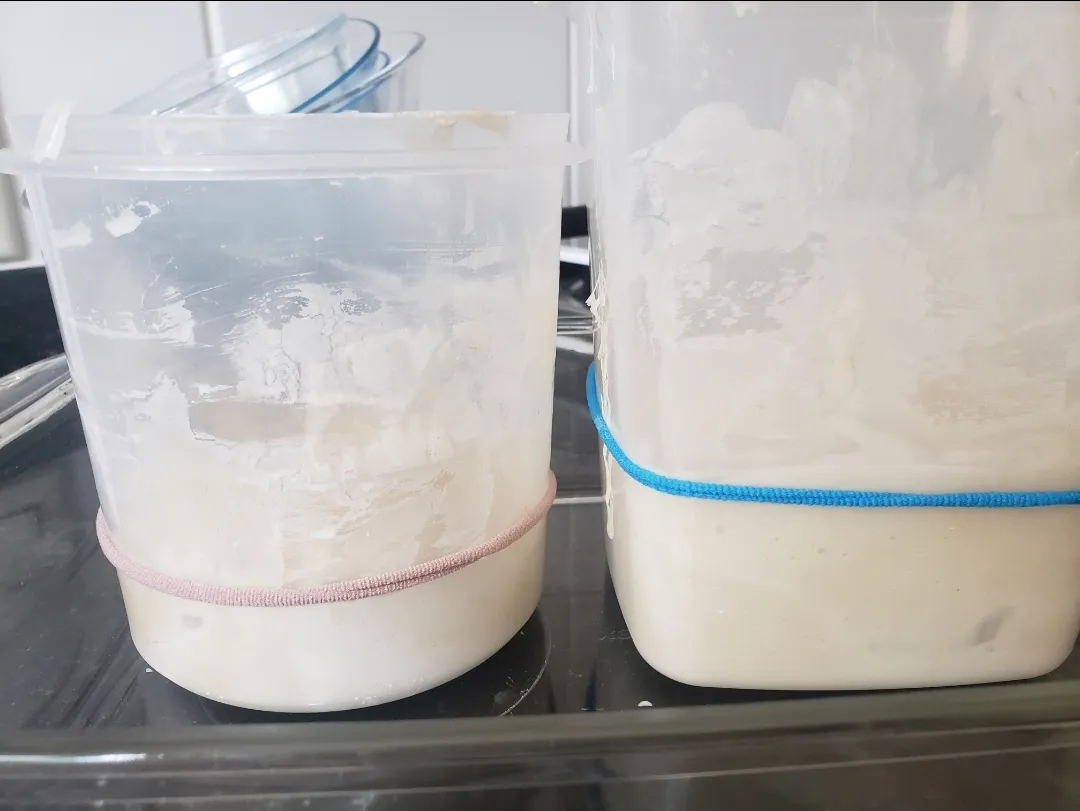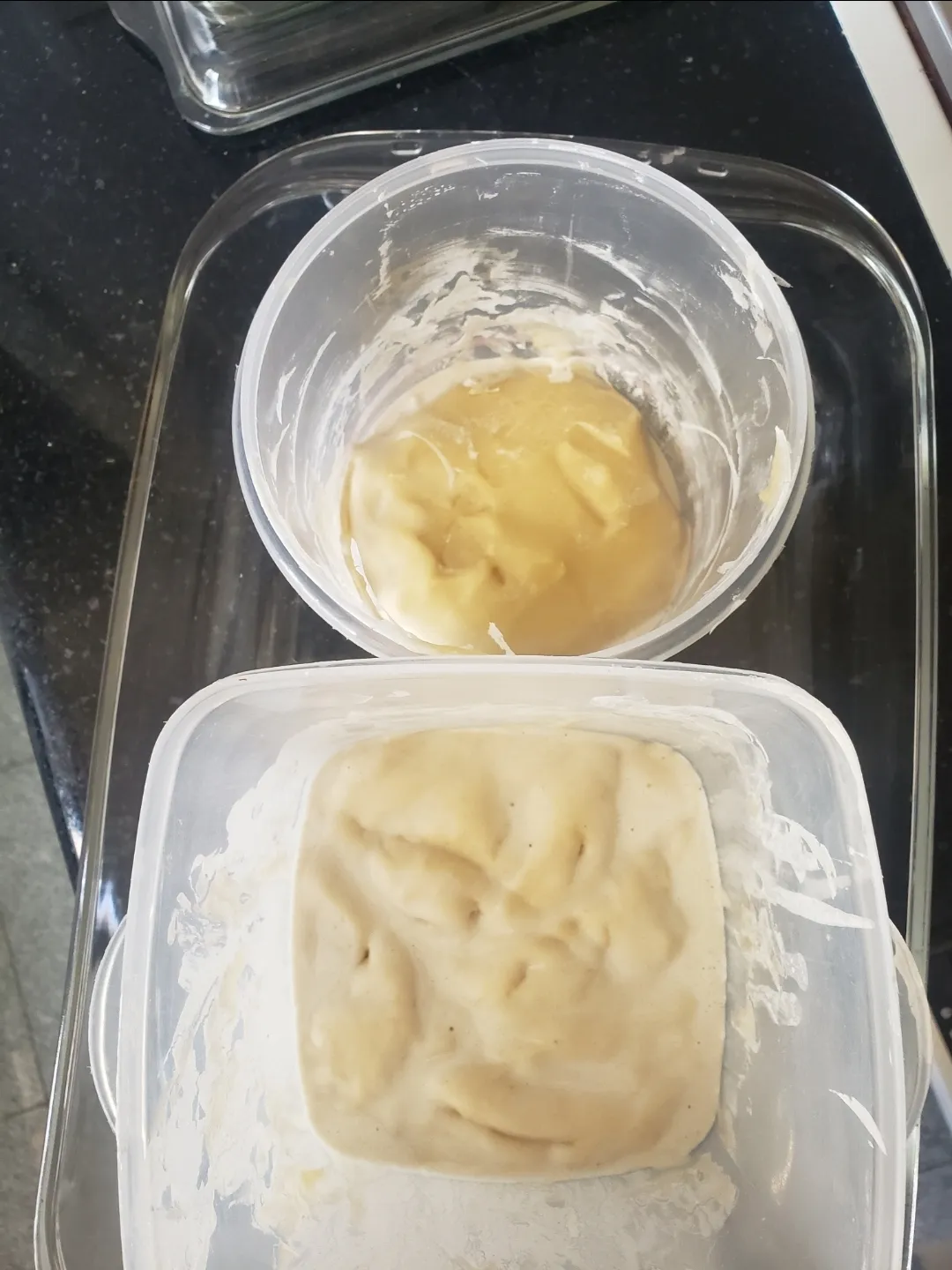Hello! So I've been trying to make a stiff start from scratch, 1st attempt to deal with and create a Panettone starter ou Lievito Madre or Pasta Madre (previous fermentation experience was with kombucha, worked wonders!)
Ive been following this recipe https://bake-street.com/en/how-to-make-stiff-sourdough-for-panettone/ and using Caputo Manitoba Oro Flour, and bottled water.
1st odd thing that didnt go so well was when I unwrapped it from the plastic bag, cotton cloth, etc on the 5th day. It was not stiff, it was quite soft. Yet it had a different and pleasant smell and the color of the starter which was in contact with the plastic was a light brown, darker than the inside
So I tried to go on according to the recipe, mixed it with flour, water, etc. I added it to a container, filled with water and let it rest overnight.
12h later it was a mess: the water was almost white, it was not floating at all, had a lot of debris sinked and was disintegrating. I could see some (quite few actually) huge alveoli on the wall.
I had absolutely no idea what to do with it but I decided to remove it from the water, added it to another plastic container and let it rest inside the oven with the light on. I tore it apart, there were some alveoli indeed but mostly it is just a light gray-ish mass.
Tried to search the internet on how to save it but I do not know what should be made and IF it can be saved
I found this website https://allyoukneadisbread.com/troubleshooting-my-lievito-madre/
I guess i had some mistakes done: overworked the dough, made it too thin when it should had been thicker, maybe overhydrated it when adding water, and maybe the manitoba flour could had been mixed with another one so that there could be more nutrients available
I'd love to hear some ideas on what to do now. I will start a regular starter anyway to compare later on if I can make it to the Panetonne-making part, Im not giving up, oh no! But im 90% confused and dont know what to do with that awkward soggy flour thing that is sitting in my oven right now LOL


The Bake Street page is good, but there is so much info there... if you are on day 5, then you had 200g LM from the last refresh (cut from the center of your LM at the end of the last refresh), 200g flour, and 80g water (this is 40% hydration. So, the ratio is 1:1:.4
With water storage, sometimes the problem can be that water has gotten into your coil and so the hydration on the next round is too high and the LM is too soft. That might have happened to you. If so, just adjust hydration downwards until you get a firm but not hard dough.
You also might want to try just storing it dry rather than in water for a couple of cycles, to get the dough manageable.
I am aware this will be (probably) a quite silly question but i am kind of lost so yeap, i have to ask it
how can i store it dry for a few cycles? I am guessing i could store it back in a plastic bag and linen and feed it every 2 days.... but i am not sure if this was what you meant. When i try searching for it all i can find is how to dry the sourdough to store it long term
I store my LM for a week or two by doing this:
Feed at double the usual amount, then wrap the log of LM first in plastic wrap, then in a dish towel, roll up and wrap cord around it to loosely bind it. The LM will continue to rise in the refrigerator and make the package tight.
So, I feed at 1:2:.4 This would be perhaps 100g starter, 200g flour, 80g water
Then mix for 7 minutes low speed in planetary mixer (Kitchen Aid) using a spiral dough hook.
Put the LM in a plastic bag for 10 minutes to relax
Then either laminate or knead until very smooth. Shape into a log and store as above.
Place in very cold refrigerator for a week or more
Breakdown is to be expected with any new starter, incl. lievito madre.
Once you give it several refreshes in a row that propensity to degrade will diminish.
I find it interesting that they start with Apples. I suppose the yeast on apples and the low hydration of the dough favors a yeast that can do well in a sugary (low hydration) environment like panettone.
Ah, much to say about that...
Briefly... The characterisation of yeasts found on the skins of fruits are typically; K. apiculata & Candida spp. Yeasts which have a high demand for oxygen and low tolerance of alcohol which therefore make poor fermentative yeasts.
Fruits and fruit tree / vine anatomical parts are a good source of yeasts generally, but only do fermentative environments, those of which are generally man made, do they select for fermentative yeasts, i.e.; brewery, winery e.g....
Apple juice / pulp / puree is no different to using any source of fruit. All are catalysts for fermentation. How a SD starter is started is not massively important in the grand scheme of things.
Common SD yeasts by their nature are actually already quite ‘osmotolerant’ and the selling of so-called yeasts is not really much more than a marketing ploy...
The low hydration environment really favours heterolactic fermentation.
If that is true, why bother going through all the trouble of making an LM? Why not just use an active starter? or a CLAS and CY?
Bread made with an LM doesn't usually produce sour loaves, so what advantage would there be to favoring heterolactic fermentation?
I never suggested that the yeast on apples was unique; I posited why the yeast on apples combined with low hydration might produce a better starter for panettone. I don't know if it is true or not, but the author of the post that was linked to by the OP was pretty adamant about it, going so far as to say that the submerged version of creating the starter produced a better starter than the dry method. Either method seemed to stress the yeast for oxygen and temperature variability. I wouldn't pretend to know why, or even if the result produces better panettone, but I am curious.
Broadly a LM is just a starter, typical of a bakery type 1 sourdough, which is continuously propagated by additions of flour and water at regular intervals.
A LM starter and a traditional San Francisco Sourdough starter are both characterised by the dominant heterofermentative bacteria Fructilactobacillus sanfranciscensis (formely Lactobacillus sanfranciscensis). Differences in sour are more to do with the way the starter is handled.
Indeed I understood, the point being that yeasts dominant on the skins of fruits do not make good fermenters and nor would they be found to dominate an SD starter incl. LM.
Key SD yeasts: Kazachstania / Saccharomyces.
Key yeasts found on fruits: Kloeckera apiculata / Candida spp.
If Kloeckera apiculata / Candida spp. are dominant, then one of two things is likely happening in the LM process:
If #1 is correct, then perhaps there is a better way to get an LM started than apples. Otherwise, #2 would be necessary for a proper final product.
Of course, there is always #3 - a possibility I haven't thought of.
I believe that Italian bakers used to have a preference for cow or pig dung to get their LM starters up and running.
https://www.youtube.com/watch?v=8FNEQY_G2BI&t=2576s
Lance
Actually that would likely fall under #1, in s much as it would not be one of the two mentioned yeasts ( I assume)
‘Okay, I just watched the entire link, and what I came away with is that process matters more than your starting point. The other thing that “shocked” me was the recommendation that one use dirt or manure to restart a sourdough culture.
Yes, a bit shocking, but interesting. All our lives we are told how hazardous faecal matter is to health, yet here is a process where it is deliberately introduced into the food chain (albeit in minute quantities)!
I don't know if it is still current practice, but no doubt some of the vintage starters in use will have been made this way.
I'm not sure if the public health regulatory bodies would be too keen on the idea!
Lance
Recommended it as a way to fix a stuck starter, so it sounds like it is still in use. He also said that by the 5th or 6th feeding, it would be perfectly safe. #1 because is it ingested (not put on an open wound) and #2 because it is cooked killing all microbial life.
Talk about doing something that requires a leap of faith!
And Reinhart's guest was Michael Gänzle - who knows a thing or two about sourdough!